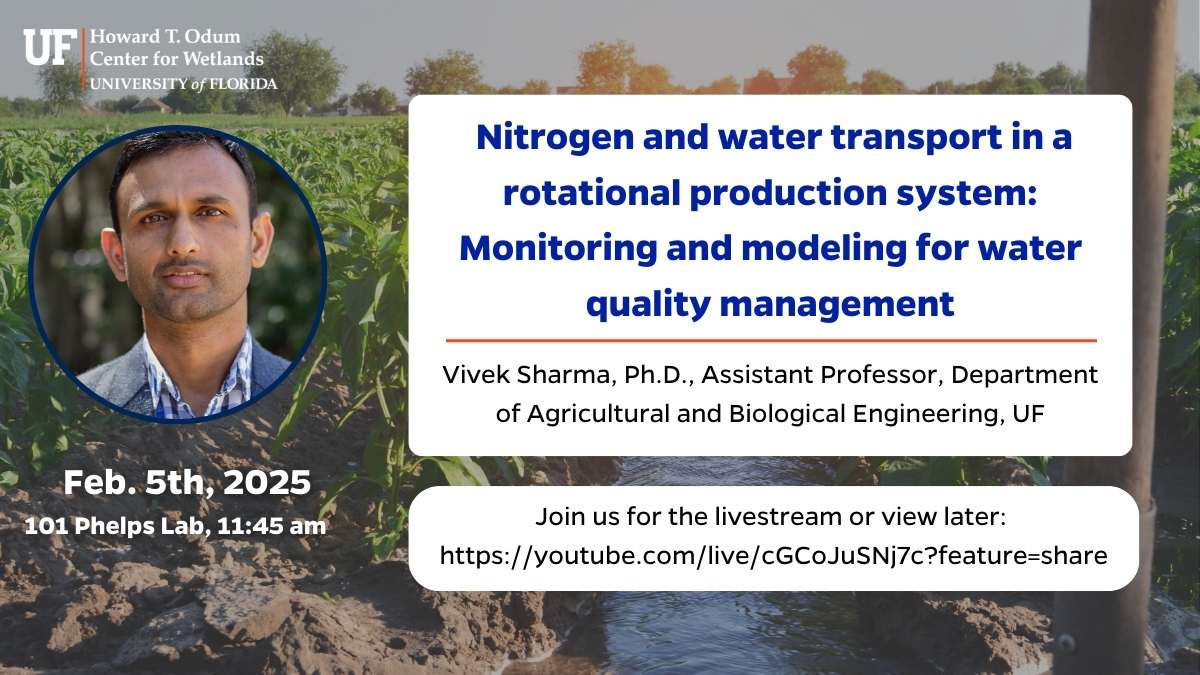
Vivek Sharma, Ph.D., assistant professor, Agricultural and Biological Engineering Department, University of Florida
Join us for the livestream February 5, 11:45am ET: https://youtube.com/live/cGCoJuSNj7c?feature=share
(Please visit our YouTube channel main page for the stream if there are any issues with the direct link.)
ABSTRACT
The use of nitrogen (N) fertilizers, both organic and inorganic, poses a risk of nitrate-nitrogen (NO3-N) loading into the environment, which is a significant concern for regions like Florida aiming to meet Total Maximum Daily Load (TMDL) standards for NO3–N. This four-year study (2019-2022) at the North Florida Research and Education Center-Suwannee Valley (NFREC-SV) in Live Oak, FL, evaluated rotational production as an advanced Best Management Practices (BMPs) to mitigate NO3–N pollution. The study compares the conventional maize (Zea mays) – peanut (Arachis hypogaea) and maize-carrot (Daucus carota) – peanut rotations with sod-based rotation involving two years of bahiagrass (Paspalum notatum) followed by maize, carrot, and peanut across a 16 ha center pivot irrigated field. The study found sod-based rotation reduced NO3–N leaching by 27 % for maize and 52 % for peanuts, and increased N use efficiency by 9 % in maize. However, conventional rotation produced higher short-term crop yields than sod-based rotation, with maize yields showing an nRMSE of 7.5 % and peanut yields showing an nRMSE of 8.7 %. The study also critically compared the efficacy of passive-wick drainage lysimeters, finding that they overestimated drainage volumes (median = 8.2 L) compared to the soil water balance approach (median = 1.7 L), highlighting the challenges of using lysimeters for deep drainage measurement in field conditions. Furthermore, the study assessed three simulation models namely DSSAT (Decision Support System for Agrotechnology Transfer), HYDRUS-1D, and SWAT (Soil and Water Assessment Tool). All the models showed a higher calibration accuracy. Both SWAT and HYDRUS 1D closely estimated NO3-N leaching during the maize growing season, with HYDRUS-1D estimating 81 kg ha-1 and SWAT estimating 82 kg ha-1, compared to the observed 110 kg ha-1 and DSSAT’s estimate of 127 kg ha-1. The study highlights the potential of combining field observations with simulation models to guide BMPs for effective environmental management in agricultural practices.
BIO
Dr. Vivek Sharma is an Assistant Professor, Precision Water Management Specialist in the Agricultural and Biological Engineering Department, at University of Florida (UF). Dr. Sharma’s research and extension program is focused on the application and development of precision agricultural water management technologies and strategies to (i) enhance/improve water and nitrogen use efficiency, (ii) reduce agricultural water use, and (iii) reduce the impacts of agricultural management practices on downstream resources, users and water quality. His work also investigates concepts of irrigation science and engineering aiming towards the quantification of crop water use/evapotranspiration (ET), irrigation scheduling and requirements, soil moisture sensing, soil and crop growth dynamics, crop water productivity (CWP), and impact of climate variables on agricultural productivity. The main idea of Dr. Sharma’s extension program is to provide leadership and encourage agents and producers to adopt the basic, advanced, and newer technologies that will enable them to use and manage water resources efficiently and help them to increase on-farm water use efficiency.
Dr. Sharma completed his Ph.D. and M.S. in Agricultural and Biological Systems Engineering from the Department of Biological Systems Engineering at University of Nebraska, Lincoln in 2014 and 2011, respectively. His undergraduate degree is in Agricultural Engineering from Punjab Agricultural University, India. Before joining UF, Dr. Sharma worked as an Assistant Professor, Irrigation Specialist at University of Wyoming.
POSTCARD
